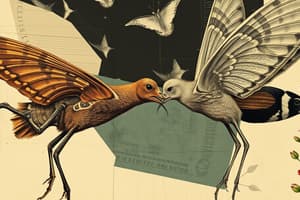Podcast
Questions and Answers
What is the definition of species-typical behavior in the context of assessing animal well-being in zoos? The repertoire of ___ that ___ how
a particular species behaves ___ __ ___.
What is the definition of species-typical behavior in the context of assessing animal well-being in zoos? The repertoire of ___ that ___ how a particular species behaves ___ __ ___.
behaviours, characterise, in the wild
Define abnormal or aberrant behavior in the context of assessing animal well-being in zoos. Unusual or ___ behaviour that might be
____. STEREOTYPIC BEHAVIOUR
Define abnormal or aberrant behavior in the context of assessing animal well-being in zoos. Unusual or ___ behaviour that might be ____. STEREOTYPIC BEHAVIOUR
rare, pathological
What is stereotypic behavior and what does it indicate about an animal's well-being? A ____, ____ behaviour, which may be the
result of frustration, attempts to cope with
suboptimal environment, or a ___ of the
central nervous system.
What is stereotypic behavior and what does it indicate about an animal's well-being? A ____, ____ behaviour, which may be the result of frustration, attempts to cope with suboptimal environment, or a ___ of the central nervous system.
repetitive, invariant, dysfunction
What is stereotypic behavior and what does it indicate about an animal's well-being?
weaving
bar-biting
head-shaking
-
feather plucking
-
What is stereotypic behavior and what does it indicate about an animal's well-being?
weaving
bar-biting head-shaking - feather plucking -
Name five categories of enrichment used to improve animal well-being in zoos.
1.___ ___ (centred on type & delivery of
2. ____ (changes to structural environment
permanent or temporary or provision of objects to
manipulate)
3. ____ (stimulates senses what they see, hear, or
smell)
4.____(interactions with other animals same or
different species or people)
5. ____ (problem solving
Name five categories of enrichment used to improve animal well-being in zoos. 1.___ ___ (centred on type & delivery of 2. ____ (changes to structural environment permanent or temporary or provision of objects to manipulate) 3. ____ (stimulates senses what they see, hear, or smell) 4.____(interactions with other animals same or different species or people) 5. ____ (problem solving
Why is behavior the most common measure used in non-invasive behavioral research with animals in zoos?
Used to understand how an animal is ___ with
life in the ___ and how it responds to its ____.
Many benefits to measuring behaviour:
–
Easy to ___
–
–
Non ___
Why is behavior the most common measure used in non-invasive behavioral research with animals in zoos? Used to understand how an animal is ___ with life in the ___ and how it responds to its ____.
Many benefits to measuring behaviour: – Easy to ___ –
– Non ___
What are published activity budgets and how are they used in comparing behavior in zoos to behavior in the wild?
____ ___ ____(a quantitative
representation of proportion of time an animal
spends engaged in behaviour or activities; Hosey et
al, 2009) as a guide for “normal behaviour”
____(a list of behaviours, with operational
definitions, observed in a species or group; Hosey
et al, 2009)
____ ____(to investigate how animals use
their enclosure or space)
What are published activity budgets and how are they used in comparing behavior in zoos to behavior in the wild?
____ ___ ____(a quantitative
representation of proportion of time an animal
spends engaged in behaviour or activities; Hosey et
al, 2009) as a guide for “normal behaviour”
____(a list of behaviours, with operational definitions, observed in a species or group; Hosey et al, 2009)
____ ____(to investigate how animals use their enclosure or space)
Flashcards are hidden until you start studying
Study Notes
Assessing Animal Well-being in Zoos
- Species-typical behavior refers to the repertoire of behaviors that demonstrate how a particular species behaves naturally.
- Abnormal or aberrant behavior is defined as unusual behavior that may be indicative of stress, boredom, or other welfare issues.
Stereotypic Behavior
- Stereotypic behavior is a repetitive, abnormal behavior that may be the result of frustration, attempts to cope with a suboptimal environment, or a dysfunction of the central nervous system.
- Examples of stereotypic behaviors include weaving, bar-biting, head-shaking, and feather plucking.
- Stereotypic behavior indicates poor animal well-being and can be a sign of stress or boredom.
Enrichment Categories
- There are five categories of enrichment used to improve animal well-being in zoos:
- Sensorimotor enrichment (centred on type and delivery of food)
- Environmental enrichment (changes to structural environment, permanent or temporary, or provision of objects to manipulate)
- Sensory enrichment (stimulates senses of what they see, hear, or smell)
- Social enrichment (interactions with other animals, same or different species, or people)
- Cognitive enrichment (problem-solving)
Behavioral Research
- Behavior is the most common measure used in non-invasive behavioral research with animals in zoos.
- Measuring behavior helps understand how an animal is coping with life in the zoo and how it responds to its environment.
- Benefits of measuring behavior include:
- Easy to observe
- Non-invasive
- Can be used to identify welfare issues
Published Activity Budgets
- Published activity budgets provide a quantitative representation of the proportion of time an animal spends engaged in specific behaviors or activities.
- These budgets serve as a guide for "normal behavior" and can be used to compare behavior in zoos to behavior in the wild.
- Activity budgets can also be used to investigate how animals use their enclosure or space.
Studying That Suits You
Use AI to generate personalized quizzes and flashcards to suit your learning preferences.



